Exploring Kidney Pathologies with Physiology & Pathology
Posted on 10/24/19 by Adelaide Elkin and Laura Snider
Visible Body’s newest app, Physiology & Pathology, features illustrations, animations, and 3D models covering a wide range of common pathologies of various body systems. In today’s blog post, we’ll use Physiology & Pathology to explore five kidney pathologies!
Before jumping into what can go wrong, let’s talk about what happens in a happy, healthy, and functional kidney! Vital to the urinary system, the kidneys’ role is to filter the blood and create urine.
Kidney Structure & Function
Located behind the abdomen and on either side of the spine, the two bean-shaped kidneys expel the urine through two long and thin tubes called ureters which are attached to the bladder.
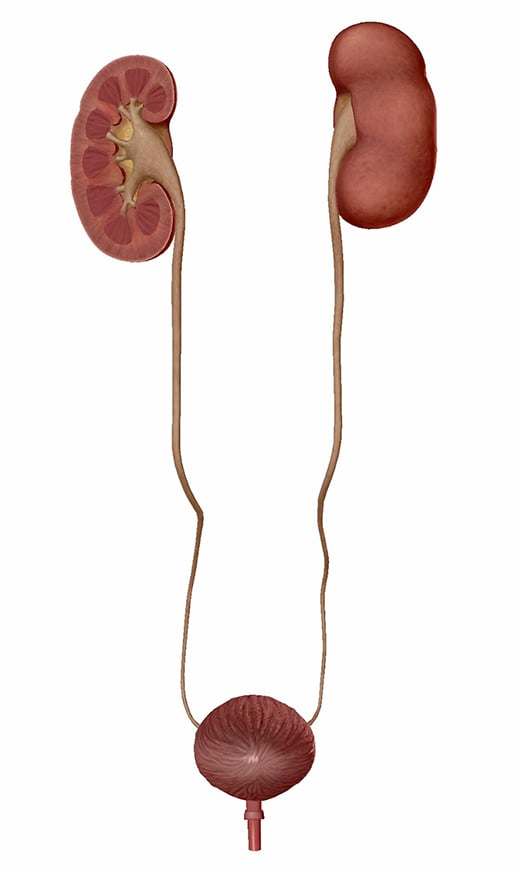
The kidneys, ureter, and bladder. Image from Human Anatomy Atlas.
Blood filtration and urine formation take place in the nephrons, the functional units of the kidneys.
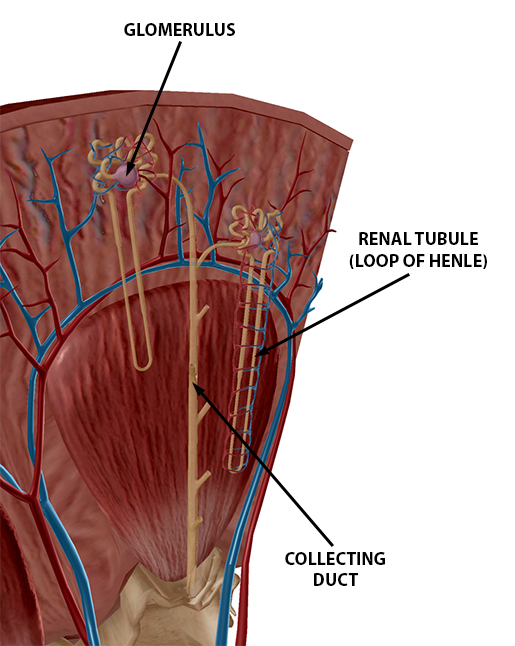 Nephron structures. Image from Physiology & Pathology.
Nephron structures. Image from Physiology & Pathology.
Within each nephron, the glomerulus filters the blood, allowing smaller molecules and debris (filtrate) to pass through, and into the renal tubule, while keeping larger molecules and cells inside the blood vessels. As the filtrate travels through the renal tubule, necessary substances such as nutrients and water are returned to the blood. Additional waste is also secreted into the filtrate. At that point, the filtrate has become urine, and it flows through the collecting duct, into the renal pelvis, and out through the ureter.
Kidney Pathologies
Now, let's jump into what happens when things go sideways in the kidney, shall we?
1. UTIs
A UTI, or urinary tract infection, occurs when any part of the urinary system gets infected. This includes the kidneys, bladder, ureters, and urethra. The infection typically occurs when bacteria enter the urethra and travel into the bladder. This essentially grants the bacteria free access to any part of the urinary system.
Things like sexual activity, menopause, and certain types of birth control can increase the risk of getting a UTI in women.
Most UTI cases occur in the bladder or the urethra, but sometimes the kidney becomes infected, leading to pyelonephritis. Pyelonephritis is a dangerous condition that can lead to permanent kidney damage or blood poisoning if untreated. Common symptoms are upper back and side pain, nausea, vomiting, and a high fever.
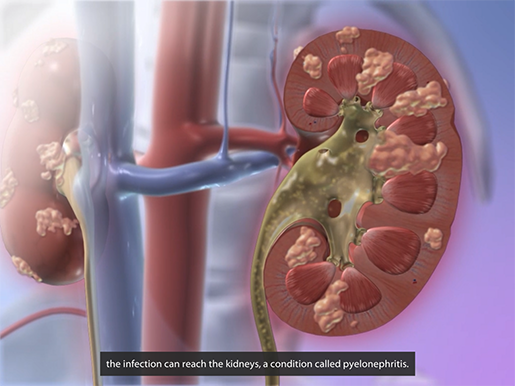 A UTI that has reached the kidneys. Animation screenshot from Physiology & Pathology.
A UTI that has reached the kidneys. Animation screenshot from Physiology & Pathology.
2. Acute Renal Failure
Acute renal failure occurs when the function of the kidneys is suddenly disrupted. There are three types of acute renal failure, depending on the location of the disruption: prerenal failure, intrinsic renal failure, and postrenal failure.
Prerenal failure occurs when blood can’t reach the kidneys. This could be due to a variety of conditions, such as hemorrhage, congestive heart failure, and dehydration. If the kidneys can’t get enough oxygenated blood, damage to the renal tubules occurs. The rate of glomerular filtration decreases, and the reabsorption of water and sodium increases, leading to electrolyte imbalance that could cause metabolic acidosis.
Intrinsic renal failure happens when the problem is in the nephron itself. Diseases of the glomeruli and renal tubules (for example, acute tubular necrosis) lead to intrinsic renal failure by disrupting filtration and absorption and secretion, respectively.
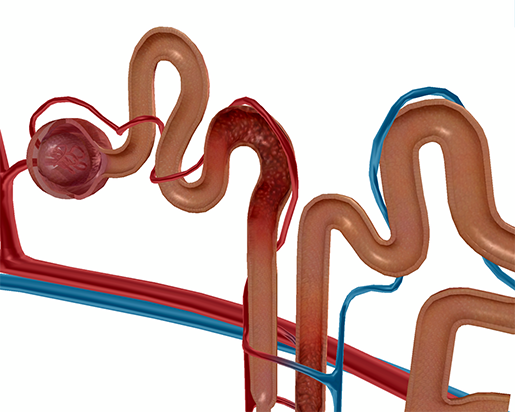 Acute tubular necrosis. Image from Physiology & Pathology.
Acute tubular necrosis. Image from Physiology & Pathology.
If a kidney stone or tumor blocks the ureters, postrenal failure can occur.
3. Chronic Renal Failure
Chronic renal failure is the gradual breakdown of kidney function. Like acute renal failure, it can occur when there is reduced blood flow to the kidneys or when nephron function is impaired.
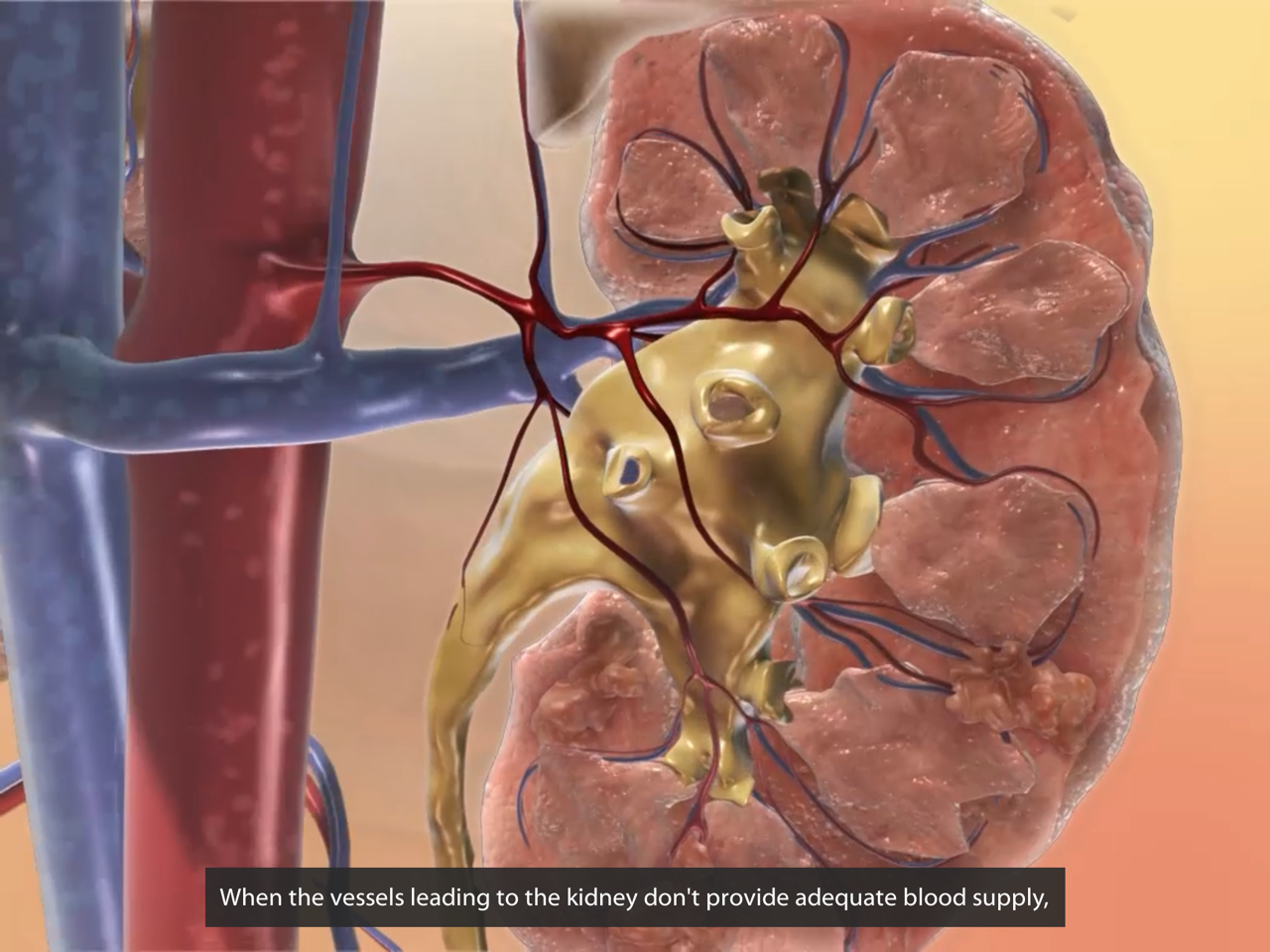 Animation screenshot from Physiology & Pathology.
Animation screenshot from Physiology & Pathology.
The effects of chronic renal failure extend beyond the buildup of waste and toxins in the blood. Calcium absorption in the body decreases, affecting bone health, because Vitamin D receptors in the kidney can no longer function. In addition, the kidneys can’t produce as much erythropoietin, which leads to a decrease in red blood cell production.
Hypertension, primary diseases of the kidney, and repeated acute renal failure can all lead to chronic renal failure.
4. Kidney Stones
Commonly the result of dehydration, kidney stones form within the kidney when the urine becomes concentrated. This causes the debris to crystallize and form hard deposits. If your urine is the color of a school bus, that’s your body’s way of saying “Drink! Water! Now!” These deposits don’t usually cause permanent damage, but they can travel to any part of the urinary system.
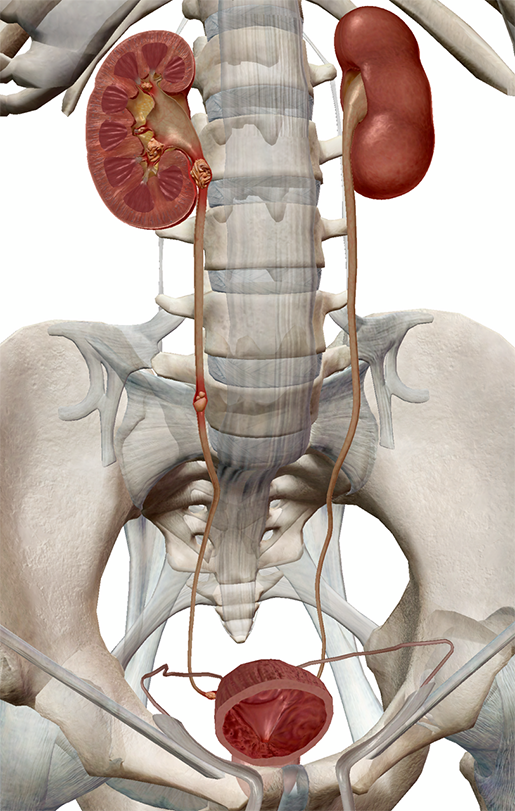 Kidney stones in the kidney and ureter. Image from Physiology & Pathology.
Kidney stones in the kidney and ureter. Image from Physiology & Pathology.
When the stone moves through the system is typically when the pain kicks in. People usually pass kidney stones by flooding the system with water and loading up on pain meds. However, if the stone gets stuck in the urinary tract, surgery may be required to remove it.
5. Polycystic Kidney Disease (PKD)
Polycystic kidney disease (PKD) is an inherited disorder in which clusters of benign cysts form within and/or on the exterior of the kidneys. This leads to enlargement of the kidneys, causing their function to gradually weaken. The cysts vary in size and depending on how large and how many cysts there are will determine the damage done to the kidney. In addition to kidney failure, high blood pressure can also be the result of PKD.
Since the disease is genetic it rarely shows up spontaneously. PKD comes in two forms: Autosomal dominant polycystic kidney disease (ADPKD) and autosomal recessive polycystic kidney disease (ARPKD). ADPKD occurs when one parent has the disease which gives the child a 50% chance of inheriting the disease. ARPKD is much less common because both parents must have abnormal genes to pass it on.
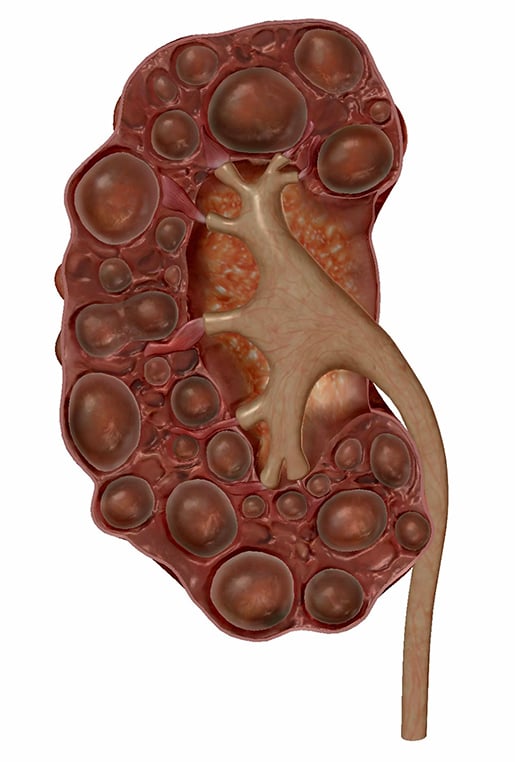 Kidney with PKD. Image from Physiology & Pathology.
Kidney with PKD. Image from Physiology & Pathology.
Check out these kidney pathologies, as well as lessons detailing normal kidney function, in Physiology and Pathology (coming soon for iOS devices)!
Be sure to subscribe to the Visible Body Blog for more anatomy awesomeness!
Are you an instructor? We have award-winning 3D products and resources for your anatomy and physiology course! Learn more here.
Additional Sources:




